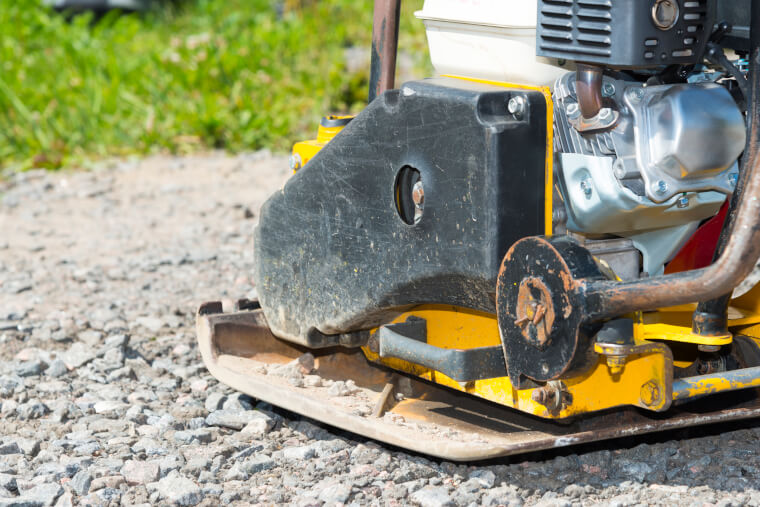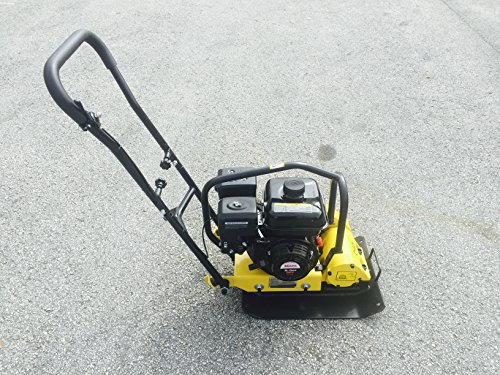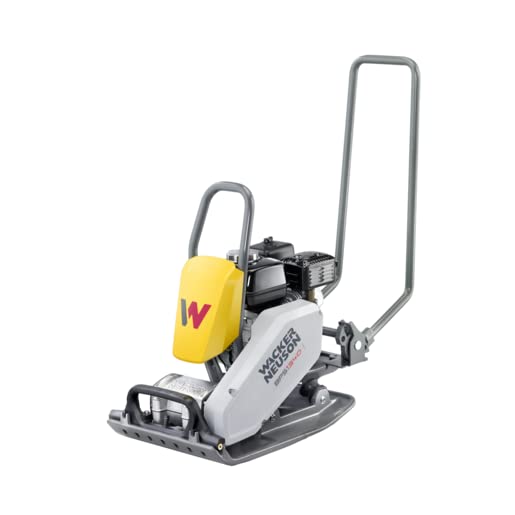Disclaimer: None of our reviews are sponsored. We earn a commission when you purchase items through our links.
Solid compact sub base / asphalt is vital to the foundations of laying new floor.
This removes the air, makes the ground more solid, and lessens the chance of cracks, potholes, or anything collapsing in the future.
For small to medium jobs like this, a vibratory plate compactor is the tool of choice.
This guide lists some of the best vibratory plate compactors on the market to help you decide which one you need for your budget.
Quick Picks
Here's 3 products we picked out that thought you would be interested in depending on your budget...
The Best Plate Compactors 2024
Here's a list of the best vibratory plate compactors we found:
1. Multiquip MVC82VHW Vibratory Plate Compactor
- Anti-vibration handle reduces vibration to the operator by 50%
- Economical price tag
- Solid, high-strength steel base plate with curved edges for excellent performance and smooth turns on hot asphalt
- The water tank holds 11.5 quarts (10.88 Liters)
- Centrifugal Force: 3080 lbf
- Plate Size: 17.7 x 22.4 in
- Forward Speed Per Minute: 72 ft
Pros
- Recognized as the industry standard for compacting granular soils and asphalt
- Easy maneuverability great for small spaces
- Cyclonic pre-cleaner to capture contaminants for engine protection
- Anti-vibration handle for user comfort
- Front mounted exciter gives easy access for maintenance and service
Cons
- Expensive
- Recommended for contracts that work on larger jobs
Overview
The Multiquip MVC82VHW is the industry standard. It has an anti-vibration handle that keeps the operator more comfortable and allows for better control. The base plate is made of solid, high-strength steel. The open base plate design also makes it easy to clean out any dirt and debris. Plus, it has curved edges that help make smooth turns, even on hot asphalt. In fact, this is a great unit for tight spaces because it’s so maneuverable. The Honda GX160 engine is really reliable, too. It starts easy, has a low oil shutdown feature, and a steel roll bar for protection.
This plate compactor is a high-quality, professional grade piece of equipment. It has great maneuverability and a lot of engine protection features in place to keep it going for a long time.
2. Tomahawk Power Plate Compactor
Pros
- Compact plate size is great for small spaces
- Easy to maneuver
- Comes with a 3-year engine guarantee and a 1-year product warranty
Cons
- Some users mentioned that they would have preferred if the speed control was on the handle, making it easier to quickly stop the machine.
Overview
The cast iron baseplate of this best plate compactor from Tomahawk is a great size because it’s able to work around cramped and narrow spaces. It’s great for granular soils and makes a perfect foundation for roadways and asphalt. While none of these machines are what we’d call “quiet,” this one was designed to be 2 decibels quieter than competitive models. But, it’s still tough enough to handle jobs for DIYers and professionals alike. The large 1-gallon fuel tank will last hours and it has a forward speed of 79 feet per minute so you’ll be able to get a lot of work done quickly.
For professionals or homeowners who work with granular soils and need something that can fit into tight spaces, the Tomahawk Power Plate Compactor is a great choice.
3. WEN 56035 Plate Compactor
- Powerful: 212cc engine is larger than most in its class, producing 4,496lbs of force at 5,400 blows per minute
- Maneuverable with our unique swing-over handle and the compact 24 x 17-3/4" contoured edge plate
- Fast Travel Speed = productivity; Single direction plate travels up to 82 feet per minute
- Vibration isolators between the welded steel plate and the engine reduce vibration extending the engine's life
- Easily transportable with lift handles at the plate, as well as central lifting/load bar
- Power Source Type: Gas Powered
Pros
- Excellent value for money
- Unique swing over handle for easy maneuverability,
- powerful and fast to get work done more quickly,
- lift handle and central lifting bar for easy loading/transport,
- vibration isolators reduce engine wear and tear.
Cons
- Holds 16 oz of oil, not 20 oz as stated in the instruction manual which caused a mess for some users
- Sides of plates have a tendency to cut a little deep
- Not made for contractors on larger jobs
Overview
The WEN 56035 has an engine that’s more powerful than other compactors in this class. It’s fast, too, which means you can cover more ground in a shorter amount of time. Because of the swing over handle and the contoured edge plate, it’s easy to maneuver into tight spaces. This is a great choice if you’re looking for a machine that’s easy to take from place to place. It has lift handles at the plate and a central lifting bar to make it easy for you and a friend to load. Plus, there are vibration isolators that not only make it more comfortable to use, they also prolong the life of the engine by cutting down on wear and tear.
The WEN 56035 is really easy to maneuver and will help you get projects done at home. Lift handles make it easy to transport, which is great because all of your friends are going to want to borrow it for their projects.
4. CORMAC C95T Plate Compactor
Pros
- Open plate design for access when cleaning or other maintenance,
- Rubber mount shock absorber to reduce vibration,
- Protective frame, sealed belt cover to protect against damage.
Cons
- Throttle control optional and not included
- Throttle cable is present and a little annoying if you don't choose to upgrade
- Exhaust blows onto operators legs
- Only good for granular materials
Overview
The Cormac 95T is a powerful design that’s perfect for granular materials like sand, gravel, and grit. The plate has an open design for easy cleaning and maintenance. It was also designed for easy access to corners and other difficult spaces. The protective frame and sealed belt cover keep it safe from excessive wear and tear. Plus, to reduce vibration, it has a heavy-duty rubber mount shock absorber. That combined with the thoughtfully designed handle makes this an easy one to push around.
This is a bargained priced machine from Cormac that’s perfect for jobs involving gravel, sand, and other granular materials.
5. YARDMAX YC0850 Plate Compactor
Pros
- Compact design is great for residential work
- Easy to fold up handle and wheels make for easy movement and transport
- Solid plate for strength and durability
Cons
- Fold up handle can interfere with the gas cap when opening and closing
- Included instruction manual isn't very clear
- Not durable enough for demanding commercial jobs
Overview
The compact design of the Yardmax YC0850 makes it a great choice for residential jobs. The plate is one solid piece, which means there are no weld beads. Over time, this keeps the plate from weakening and rusting and adds strength and smoothness. The self-propelled engine has recoil ignition for consistent performance. For vibration control, the handle has a 3-point attachment with rubber bushings. That’s not all, the handle folds down for compact storage. Plus, transport wheels are included for easy movement before and after the job.
This Yardmax YC0850 is a great choice for home use if you’re building a patio or pouring a driveway, though not up to the demands of demanding commercial jobs.
6. CORMAC C60 Plate Compactor
Pros
- Open plate design for easy cleaning and maintenance
- Able to get into tight spaces and corners
- Handle folds down for easier storage and transport
- Rounded edges to protect housing and objects on the job site
Cons
- Only works with granular materials
- Minimal complaints from users
Overview
Here’s another option from Cormac that’s another great design from the brand. This model is ideal for compacting soil, gravel, sand, or other granular materials. The open plate allows for easy cleaning and was made to fit into tight spaces and corners.
It has a rubber mount shock to reduce the effects of vibration. Plus, the protective frame and sealed belt cover help prevent sand and soil from getting in, reducing wear and tear. The rounded edges help protect objects around the job site and the foldable hand makes storage easier at the end of the day.
7. Wacker Neuson VP 1340A Plate Compactor
- Specially contoured running surfaces and rounded edges provide maximum performance and maneuverability
- Completely enclosed belt protected by a lightweight belt guard for reduced wear and minimal service
- Exciter bearing design requires minimal maintenance for improved productivity.
- Ergonomically designed lifting handles offer easier load and unloading for the operator during transport
- Plate Size: 23 x 15.5 in
- Forward Speed Per Minute: 75 ft
Pros
- Ergonomically designed handles help with loading and operation
- Countered surfaces and rounded edges for easy maneuverability
- Protected belt to avoid damage and lessen wear and tear
Cons
- A little on the expensive side but customers don't have many complaints.
Overview
One of the best things about the Wacker Neuson VP 1340A is the maneuverability. The running surfaces have been contoured and the rounded edges contribute to how easy it is to move around. The belt is completely enclosed to protect it from debris, damage, and wear and tear. That also means you’ll have minimal maintenance to perform. For easier operation and loading, the handles have been ergonomically designed to help you stay comfortable and get a good grip on things.
For a great, all-around performer that’s reliable and built to last, the Wacker Neuson VP 1340A deserves a closer look. It’s suitable for most professional jobs and a powerful choice.
What’s a Plate Compactor used for?
Plate compactors can be used for a variety of different things. Their primary purpose is to compact soil, gravel, loose stones, or sand before paving a road, driveway, or patio. Some more powerful and high-end models can even be used to smooth patches of fresh asphalt. This comes in really handy in smaller spaces and tight corners where a road roller isn’t going to be able to reach.
There are a few different kinds of plate compactors that can do this job. They all basically do the same thing but operate a little differently and are appropriate for different kinds of jobs.
The first kind is a hydraulic compactor. This is meant for large construction sites. It mounts onto an excavator or a backhoe and can compact just about anything. Hydraulic compactors are exclusively used by contractors and other professionals experiences with using heavy pieces of machinery.
Next is a rammer compactor. These are the lightest weight of the bunch and are used for prepping interior floors for nex construction or to make repairs to streets, shoulders, and highways.
The last kind is our vibrating plate compactor. These machines have a vibrating metal plate that forces air out of the ground so that there’s less risk of settling and damage in the future. Basically, they help you get a good foundation for a better quality end product. They’re easy to maneuver and are ideal for tight areas and corners.
Plate Compactor Buying Guide
Now that you read our plate compactor reviews, let’s take a closer look at the things you need to consider before you invest in the best plate compactor for pavers.
The Plate
The plate is the part of the machine that makes repeated contact with the surface. They come in various sizes, are somewhat rectangular or square in shape, and usually range between 15 and 25 inches. There’s a lot to consider about the plate because it’s the part of the machine that’s going to be doing the actual work.
The exciter speed is an important thing to consider. This is also called the “eccentric frequency” and measures how many vibrations per minute the plate has. Consider the material you’re going to be working with when you choose a compactor. Basically, the more coarse the material you’ll be compacting, the higher VPM you need. So, for sand or soil, you can use a lower VPM than for asphalt or rocks.
Consider the plate material, too. Most are made of steel but there are cast iron ones available, too. For most residential purposes, steel is great. But, for larger more involved jobs, cast iron plates are more efficient because they’re a little stiffer than steel, believe it or not. It has more compression strength and is, therefore, a little better suited to the job.
Plate shape also affects performance. They’re all generally rectangular in shape but some are more curved than others. The more curve a plate has, the easier it is to maneuver. It will also prevent any gouges and move much more smoothly over a variety of surfaces.
Some brands have an open-plate design that allows for low-maintenance and self-cleaning. If you do a lot of work and don’t always have time to clean at the end of the day, look into a vibrating compressor with an open-plate.
Water Tanks
If you’re going to use you vibrating compactor to smooth hot asphalt, it has to be equipped with a water tank. The water puts a barrier between the plate and the hot asphalt, preventing it from sticking and cooling it down as you compress it into place.
Handles
These machines are pretty heavy and work by the operator pushing them along the ground for long period of time while they vibrate. It’s not hard to see why the handle is so important. Newer models of these machines come with anti-vibration handles that make it a little easier to operate. Have a center-mounted handle helps, too, because it keeps the weight evenly distributed, making it easier to control.
Some of the products in our reviews come with folding handles. This feature really helps when you’re trying to store the machine between jobs.
Forward Speed per Minute
The higher this forward speed per minute, the quicker you’ll get the job done. The number that’s given for this value is the maximum speed. It could change depending on the material being compacted and if there are any bumps or changes in elevation on the terrain.
Comfort
We’ve already touched on this a little but it’s important to remember how physically taxing it is to operate these machine, especially if you’re going to be working with a large area.
What Plate Compactor Do I Need?
As with most tools, the one you need depends on the job you’re planning to do. The larger and more difficult to job, the bigger the compactor should be.
Most homeowners use these machines to prep for a new driveway, car park, path, or patio. As long as you’re familiar with your property and the kind of material you’re working with, you should have no problem choosing one that’s right for the job.
If you’re interested in getting one to tackle a larger project or to use for a landscaping or construction company, make sure you get one that’s built to stand up to professional level use. Consider the materials you’ll be working with but also how much use the machine will be getting. Doing a project in your yard every summer is one thing; doing multiple projects in all of your customers’ yard every week for the summer is quite another.
Who Needs a Vibrating Plate Compressor?
Do you absolutely have to have a vibrating plate compressor to do projects around your home and yard? No, the truth is, you can probably get by without ever having one. That said, there are a lot of great reasons to invest in one, especially if you are someone who enjoys doing outdoor improvements to your property.
If you have the budget, it’s really something that you’ll get a lot of use out of over the years, especially if you own a home. If you want to, say, add a concrete path from your front yard to the back or add another section to your patio, you’ll definitely need one of these. Plus, think about this: while it might be a bit of a financial investment, the projects that you’re doing to your home could potentially increase the resale value much more than the cost of the machine.
This is the kind of thing that, once you have one, you’ll keep finding reasons to use it. You can compact the ground beneath your flowerbeds before you replant them in the spring or level the ground for an above-ground swimming pool. Your neighbors will likely be jealous, too, so expect people to ask you if they can borrow it.






Comments